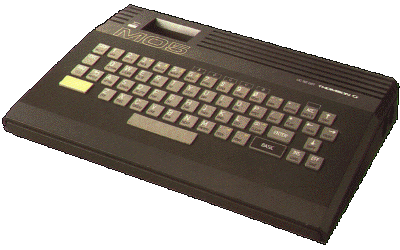Historical context
The MO5 is a home computer which was designed and distributed by Thomson (a french company) in the early eighties. This machine was powered by the best processor in its category at that time, the 6809E from Motorola. The clock speed of this 8-bit processor was 1 MHz. The commercial success of this machine is mainly due to contracts from the french government whose goal was to spread computer science in the primary schools. (mainly by the "Informatique Pour Tous" project, 1985).

Unfortunately, Thomson made a number of marketing mistakes, which contributed a lot to the end of the computer design department in 1989 (it was created in 1979). Some interesting projects, like a 68000-based computer (running the multitasking operating system OS/9-68000), would never come out.
Thomson designed the following machines (by order of appearence): TO7 (1981), MO5, TO7-70 (1984), TO9 (1985), MO6, TO8 (1986), TO8D, TO9+ (1987), all powered by the 6809E, and the TO16, a PC-XT compatible (1987), powered by the 8088-9.54MHz.
Technical specifications
- 6809E processor, 1 MHz clock
- 48 KB RAM, including 16 KB graphic RAM
- 320x200 pixels screen resolution, 16 colors
- 20 KB ROM with built-in Microsoft BASIC
- 1 expansion slot
- Connectors for lightpen, tape recorder, ROM cartridges
- 1-bit DAC for sound
Available peripherals
- MO5 extension (three expansion slots, parallel port, embedded 2'8-100KB floppy disk drive)
- 5'1/4 floppy disk drive (160 KB or 320 KB per disk)
- 3'1/2 floppy disk drive (640 KB per disk)
- Quick Disk Drive (QDD) (2'8 floppies containing 100 KB)
- "Musique et jeux" extension (2 joysticks, 6-bit DAC)
- Serial and parallel ports
- 40 and 80 column dot and thermal printers
- Lightpen
- Tape recorder
- Video inlaying
- Memory extension (64 KB RAM)
- Network interface ("Nanoréseau LÉANORD")
- Robot controllers
- Speech synthesis
- CANDI (2 8-bit ADCs, 1 TTL I/O)
- MIDI interface
Programming languages
- FORTH
- LOGO SOLI
- Microsoft BASIC
- Microsoft 6809 ASSEMBLER
- PASCAL Base
- LSE



